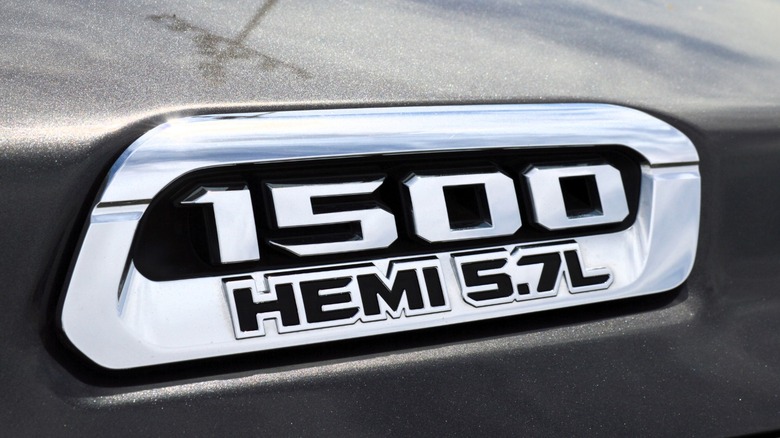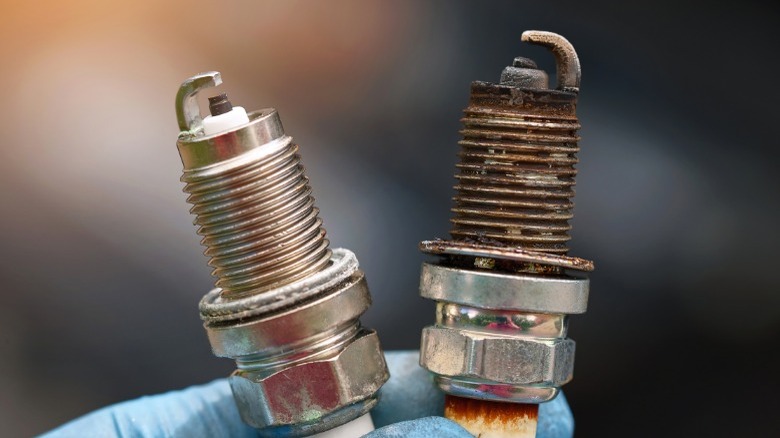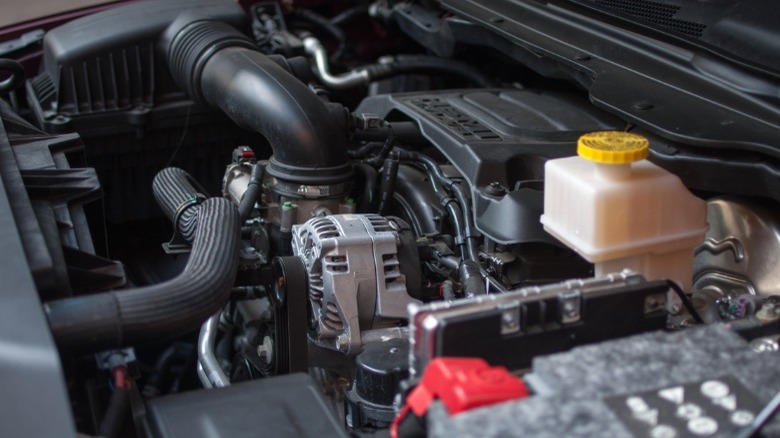How Often Should You Change The Spark Plugs In A 5.7 HEMI?
Chrysler's 5.7-liter HEMI engine is one of the most iconic Mopar engines of all time. A lot of factors contribute to the 5.7 HEMI's power and performance, but one of its most interesting characteristics is its use of dual ignition. Dual ignition refers to engine systems that use two spark plugs per combustion chamber, instead of the standard single spark plug used by most motors. These systems provide several benefits, including things like improved fuel mileage, faster ignition, and a backup in the event that one spark plug fails.
That means your 5.7 HEMI actually has 16 spark plugs instead of eight. But apart from being interesting, does that really mean anything for you and your day-to-day life, and does it affect the frequency with which you need to replace your spark plugs? The answer is essentially no. Owning a vehicle with dual ignition doesn't change the way you drive, and you still need to replace your spark plugs regularly. When it comes to a 5.7 HEMI, how often you need to change your spark plugs depends on the model year. For vehicles built prior to 2014, Chrysler recommends replacing the plugs every 30,000 miles. For newer vehicles built from 2014 onward, Chrysler recommends replacing the spark plugs every 100,000 miles.
If you're interested in learning more about your 5.7 HEMI's spark plugs, we've got you covered. As a former automotive repair technician who has worked on countless 5.7 HEMI vehicles, I'll help break it down for you. Together, we'll explore 5.7 HEMI spark plugs in greater detail, including what they do, the signs that you need to change them, and whether you can do it yourself.
What do spark plugs do for your 5.7 HEMI engine?
Spark plugs are essential components for gasoline-powered motors. Most of us are familiar with the term internal combustion engine and recognize it as the phrase we use to refer to the motors that drive our modern cars. However, many people may not fully understand that the term derives its name from the process that these engines use to propel us down the road. Let's explain.
Internal combustion engines get their power from small, contained explosions inside the motor. That's why we use the term internal combustion when talking about these devices. But those explosions don't happen spontaneously. In reality, our engines are capable of functioning thanks to a precise combination of fuel, oxygen, and electricity.
Your car's air intake and fuel systems are responsible for sending exact amounts of oxygen and gasoline to the combustion chambers. The electricity comes from your ignition system. When you turn your key to start the engine, an electric current is sent to the spark plugs, creating an electric spark that ignites the air/fuel mixture. The resulting explosions propel the pistons inside your engine up and down, causing the crankshaft to rotate and sending power to your transmission and the wheels.
What are the signs that you need to replace your 5.7 HEMI spark plugs?
If you own a used 5.7 HEMI and aren't sure whether the previous owner ever replaced the spark plugs, you may be wondering if there are any signs that you need to change them. The answer is yes — there are a few signs that can indicate that it's time to replace your spark plugs.
One of the most common signs that you need to replace your spark plugs is an engine misfire. A few different issues can cause engine misfires, but worn-out spark plugs are a common culprit. Symptoms include things like unsteady engine performance, popping sounds, and a loss of power. Another common sign of faulty or worn-out spark plugs is a drop in fuel mileage. If the plugs aren't igniting the fuel/air mixture properly, the gas won't be able to burn correctly, resulting in a drop in your fuel economy and an increase in trips to the pump.
Some of the other symptoms that you may experience if you need to change your spark plugs include a rough engine idle, difficulty accelerating, a hard time starting the engine, strange noises, and a check engine light (CEL). It's important to remember, though, that these issues can be the result of various problems. If you're not an experienced car person or mechanic and your 5.7 HEMI starts displaying these symptoms, the best move is to visit a professional automotive technician as soon as possible.
How to replace your 5.7 HEMI spark plugs
Replacing your spark plugs, or performing an engine tune-up, is a relatively straightforward procedure, and it can be a great DIY project for moderately-experienced drivers. If you pay to have the service performed by a pro, it will likely cost you around $300, depending on the labor rates in your area. While that's not the most expensive auto maintenance job, if you perform the service yourself, you should be able to save around $100 to $200 in labor fees.
If you plan to change the spark plugs in your 5.7 HEMI at home, you'll need a basic socket set, a spark plug socket, a gap tool, a torque wrench, dielectric grease, and 16 new spark plugs. A few other tools, including an impact wrench, may be helpful, but as long as you have the basics, you should be able to knock out the job without issues. Once you've got your tools handy, you're ready to get started on the following steps.
-
Open the hood and remove the air intake, engine covers, and any other components blocking access to the engine.
-
Disconnect the clips securing the electrical connectors to the spark plug coil packs.
-
Remove the coil packs and label them so that you remember where they go.
-
Remove the old spark plugs.
-
Install the new plugs by finger tightening them (do not use an impact wrench or ratchet to install the plugs).
-
Use your torque wrench to tighten the plugs to the proper specification.
-
Place a small dab of dielectric grease on the bottom of each coil pack and reinstall them.
-
Reconnect the electrical connections and replace the air intake, engine covers, and other components.
The above steps represent a generalized outline. The actual steps may differ depending on your 5.7 HEMI's model year and options.



